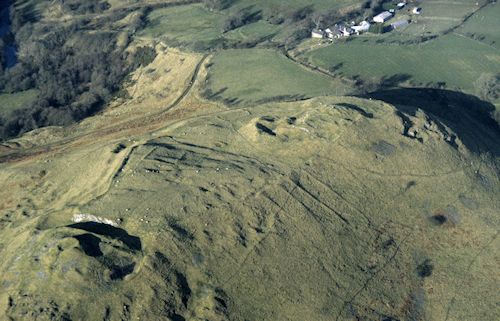
Many of the defended enclosures of Iron Age date considered here are assumed to have been abandoned at some point in the succeeding Roman period if not earlier. Excavation has revealed, however, that a few were occupied (or, more realistically perhaps, reoccupied) in the centuries following the Roman withdrawal and it may be that this practice was more widespread than is currently appreciated. Examples include New Pieces Camp on the Breiddin hills and the multi-ditched enclosure at Arddleen (O'Neil 1937; Grant 2004, 28), both in the Severn valley region, where post-Roman communities re-inhabited enclosures that were first established in the late Iron Age.
In the century or so immediately after the initial Norman Conquest at the end of the 11th century, disused Roman forts proved an attractive proposition to Marcher lords seeking to construct strongholds in their territories, who could convert the disused earthworks of their predecessors to their own purposes. Mottes were placed within the defences of the forts at Colwyn Castle (Rads) and Caerau, Beulah (Brecs) (Frere 2004; Jarrett 1969, 46) and further west in Ardudwy, the Roman fort proved an attraction to the Welsh builders of the motte of Tomen-y-mur (Gwynedd), who were able to incorporate the sizeable core of the north-west gate in the mound's construction (King and Kenyon 2001, 415).
Similarly, some defended enclosures took on a further lease of life as centres of manorial power in the post-Conquest era. Where suitable earthworks with defensive potential existed, they could be adapted to a new use, significantly reducing the labour needed in the construction of the castle. Whether non-military considerations invoking the re-assertion of control and prestige should come into play has also been discussed (Creighton 2002, 38; Higham and Barker 1992, 200). On a ridge isolated by a pronounced loop of the River Irfon is Cefnllys, a hillfort whose stony bank encloses around 2ha. To establish now whether it was solely the imposing natural location that attracted a medieval lord or whether the presence of Iron Age defences around the perimeter of the ridge was a significant inducement is impossible, but Cefnllys provides both. Within the defences are two castles at opposite ends of the ridge, the motte with two baileys at the north-east end generally assumed to have been superseded by the small stone-built castle at the south-west (Brown 1972). While the extent to which the castle builders at Cefnllys put the Iron Age enclosure to use can only be supposed, the dependency on Iron Age earthworks was fundamental to the development of the medieval castle at Castell Dinas at the head of the Rhiangoll valley close to the northern escarpment of the Black Mountains, one of the chief seats in the lordship of Blaenllynfi (RCAHMW 1986, 96). The defences as now seen around the castle are Iron Age in origin, though perhaps strengthened by medieval lords, and it is only the wall with its rock-cut ditch immediately south of the castle that appears to have been a wholly medieval feature (Figure 16)
.
Cefnllys, Castell Dinas and Caus Castle in Westbury (Salop), among others, are exceptional in that the relationship between the prehistoric and medieval earthworks can generally be unravelled without recourse to excavation. The situation is less clear-cut at other medieval earthwork castles. Knucklas Castle (Rads) is a medieval motte occupying about one-third of an enclosure of just over 2 hectares, large for a bailey, though not exceptionally so. There is no stratigraphic evidence to indicate that the kidney-shaped enclosure is of Iron Age origin, just a belief among some historians that will only be confirmed by excavation (King 1983, 409; Remfry 1996, 99). On the other hand, on Cefn Du between Castle Caereinion and Meifod (Monts) the elliptical hillfort following the contours of a steep narrow ridge is indisputable, but at its more accessible end a natural hillock has been scarped to create what may have been a motte with the inner hillfort enclosure functioning as a bailey.
Across eastern central Wales there are at least six medieval castles where the builders seem to have modified late prehistoric enclosures for a new use: it is perhaps surprising that there aren't more.
Internet Archaeology is an open access journal based in the Department of Archaeology, University of York. Except where otherwise noted, content from this work may be used under the terms of the Creative Commons Attribution 3.0 (CC BY) Unported licence, which permits unrestricted use, distribution, and reproduction in any medium, provided that attribution to the author(s), the title of the work, the Internet Archaeology journal and the relevant URL/DOI are given.
Terms and Conditions | Legal Statements | Privacy Policy | Cookies Policy | Citing Internet Archaeology
Internet Archaeology content is preserved for the long term with the Archaeology Data Service. Help sustain and support open access publication by donating to our Open Access Archaeology Fund.